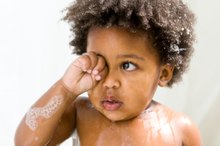Causes of Vaginal Odor in Children
Vaginitis is a common problem that impacts women of all ages, including children. Children's Hospital Boston explains that vaginitis refers to the inflammation or infection of the vagina. There are a number of causes of vaginitis. The normal microflora (balance of natural bacteria) can be disrupted by medications, harsh soaps, diapers and even poor hygiene. A medical professional should be consulted any time a child has unusual vaginal odor to ensure proper treatment.
If you are experiencing serious medical symptoms, seek emergency treatment immediately.
Natural Odor
Like adult females, children can develop a vaginal odor that is considered to be normal. Wearing a diaper can exacerbate the odor, especially when mixed with the odor of urine and feces. Bathing and frequent diaper changes can help keep the odor under control, but with no other symptoms, this type of odor is perfectly healthy. This odor can become more intense as the child enters puberty, especially as menstruation nears.
- Like adult females, children can develop a vaginal odor that is considered to be normal.
- Wearing a diaper can exacerbate the odor, especially when mixed with the odor of urine and feces.
Bacteria
Armpit Odor in Toddlers
Learn More
Bacterial vaginosis, an infection caused by bacteria, is a common ailment for females. It most often affects women of childbearing age, but it can impact children. Like yeast, bacteria are found naturally in the vagina. When the bacteria is upset and overproduces, an infection is the result. The result can be a fishy odor from the vagina with discharge. The vaginal secretions are often thin, almost milky. It can also be heavy and gray in color, explains the Children's Hospital Boston. Merck Manuals explains that a child can spread bacteria from the anus to the vagina by wiping from back to front instead of the opposite 1. Like yeast, the bacteria thrive in warm, moist environments. A child who is potty training may wear nonabsorbent underwear during this transition or may remain in soiled undergarments for extended periods of time. Other common causes of bacterial vaginosis in a child include putting a toy or tissue in the vagina or itching with dirty hands.
- Bacterial vaginosis, an infection caused by bacteria, is a common ailment for females.
- Other common causes of bacterial vaginosis in a child include putting a toy or tissue in the vagina or itching with dirty hands.
Irritation
Vaginal irritation can cause odor and other symptoms. This noninfectious form of vaginitis can be caused by perfumed soaps, detergents or fabric softeners, explains Children's Hospital. In some children this can be an allergic reaction to such chemicals. In addition to unusual odor, the child may have itching, burning or discharge. Bathing in overly soapy baths or rinsing inadequately are other ways a child can cause vaginal irritation.
- Vaginal irritation can cause odor and other symptoms.
- Bathing in overly soapy baths or rinsing inadequately are other ways a child can cause vaginal irritation.
Related Articles
References
- Merck Manuals: Vaginal Infections
- STD Facts - Bacterial Vaginosis. Centers for Disease Control and Prevention. Feb 8, 2017.
- STD Facts - Trichomoniasis. Centers for Disease Control and Prevention. Jan 31, 2017.
- Rodrigues CF, Rodrigues ME, Henriques M. Candida sp. Infections in Patients with Diabetes Mellitus. J Clin Med. 2019;8(1) doi:10.3390/jcm8010076
- Pelvic inflammatory disease. womenshealth.gov. Apr 1, 2019.
Writer Bio
Sarah Harding has written stacks of research articles dating back to 2000. She has consulted in various settings and taught courses focused on psychology. Her work has been published by ParentDish, Atkins and other clients. Harding holds a Master of Science in psychology from Capella University and is completing several certificates through the Childbirth and Postpartum Professional Association.









